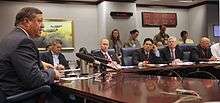Air Force Global Strike Command
Air Force Global Strike Command (AFGSC) is a Major Command (MAJCOM) of the United States Air Force, headquartered at Barksdale Air Force Base, Louisiana. AFGSC provides combat-ready forces to conduct strategic nuclear deterrence and global strike operations in support of combatant commanders.[8] It is subordinated to the USSTRATCOM.
| Air Force Global Strike Command | |
|---|---|
 Shield of Air Force Global Strike Command | |
| Active | 7 August 2009–present (As Air Force Global Strike Command) 21 March 1946 – 1 June 1992 (as Strategic Air Command) 13 December 1944 – 21 March 1946 (as Continental Air Forces) (75 years, 6 months)[1] |
| Country | United States of America |
| Branch | |
| Type | Major Command |
| Role | "Provide strategic deterrence, global strike and combat support…anytime, anywhere"[2] |
| Size | 30,646 Airmen 178 aircraft 406 ICBMs[3] |
| Part of | |
| Headquarters | Barksdale Air Force Base, Louisiana, U.S. |
| Nickname(s) | "America's Shield"[4] |
| Motto(s) | "Deter...Assure...Strike!"[2] |
| Decorations | Air Force Organization Excellence Award[1] |
| Website | www |
| Commanders | |
| Commander | Gen Timothy Ray[5] |
| Deputy Commander | Maj Gen Vito Addabbo[6] |
| Command Chief | CCM Charles R. Hoffman |
| Aircraft flown | |
| Bomber | B-1B, B-2A, B-52H[3] |
| Electronic warfare | E-4B |
| Utility helicopter | UH-1N, to be replaced by Grey Wolf[7] |
| Trainer | T-38C |
| LGM-30G | |
Air Force Global Strike Command is the direct descendant unit of the Cold War–era Strategic Air Command (SAC). It holds the lineage, history and honors of SAC.[9]
Overview
Air Force Global Strike Command (AFGSC) was established for the improvement of the management of the USAF portion of the United States' nuclear arsenal, which accounts for two-thirds of America's nuclear deterrent. It assumed responsibility for the nuclear-capable assets of Air Force Space Command on 1 December 2009 and the nuclear-capable assets of Air Combat Command on 1 February 2010.[10]
The creation of Air Force Global Strike Command was outlined in the recommendations of the investigation following the 2007 United States Air Force nuclear weapons incident. The command was activated 7 August 2009, at Barksdale Air Force Base, Louisiana.
The mission of Air Force Global Strike Command is to "Develop and provide combat-ready forces for nuclear deterrence and global strike operations --Safe --Secure --Effective to support the President of the United States and combatant commanders."[11]
AFGSC consists of over 31,000 personnel assigned to nine wings, two geographically-separated squadrons and one detachment in the continental United States and deployed to locations around the globe.[12]
Changes to the AFGSC units began with the announcement of the 377th Air Base Wing's realignment in December 2014. In mid-April 2015, Air Force Times reported that "B-1 bombers from Ellsworth Air Force Base in South Dakota and Dyess Air Force Base in Texas [will be] joining their long-range B-2 and B-52 bomber counterparts under a single Air Force command as part of a leadership shift announced Monday." This means that two bomb wings formerly under Air Combat Command will shift into AFGSC. The units came under the command on 1 October 2015.[13] On 6 October 2016, the 595th Command and Control Group was activated at Offutt Air Force Base, Nebraska to assume the responsibility for the Boeing E-4 NAOC mission.[14]
Units
The command has a worldwide Area of responsibility (AOR) as a subordinate component command of United States Strategic Command (USSTRATCOM). Installations assigned to AFGSC include Barksdale Air Force Base, Malmstrom Air Force Base, Minot Air Force Base, F. E. Warren Air Force Base, Dyess Air Force Base, Ellsworth Air Force Base, Kirtland Air Force Base, and Whiteman Air Force Base.
Eighth Air Force
Headquarters, Eighth Air Force – Barksdale Air Force Base, Louisiana[15]
Eighth Air Force is designated as U.S. Strategic Command's Task Force 204 (TF 204), providing on-alert, combat-ready forces to the President of the United States. The mission of "The Mighty Eighth" is to safeguard America's interests through strategic deterrence and global combat power. Eighth Air Force controls long-range nuclear-capable bomber assets throughout the United States and overseas locations. Its flexible, conventional and nuclear deterrence mission provides the capability to deploy forces and engage enemy threats from home station or forward positioned, anywhere, any time. The 8th Air Force motto is "Deterrence through strength, global strike on demand."[12]
- 2nd Bomb Wing – Barksdale Air Force Base, Louisiana (B-52H)
- 5th Bomb Wing – Minot Air Force Base, North Dakota (B-52H)
- 23d Bomb Squadron
- 69th Bomb Squadron
- 7th Bomb Wing – Dyess Air Force Base, Texas (B-1B)[16]
- 28th Bomb Wing – Ellsworth Air Force Base, South Dakota (B-1B)
- 509th Bomb Wing – Whiteman Air Force Base, Missouri (B-2A)
- 13th Bomb Squadron
- 393d Bomb Squadron
- 394th Combat Training Squadron
- AFGSC Direct Reporting Units (DRU)
- 576th Flight Test Squadron – Vandenberg Air Force Base, California
- 595th Command and Control Group – Offutt Air Force Base, Nebraska[17]
- The Missouri Air National Guard's 131st Bomb Wing is an associate unit of the 509th Bomb Wing at Whiteman AFB, flying the B-2A Spirit. If federalized, it is gained by Eighth Air Force.
- The Air Force Reserve Command's 307th Bomb Wing is an associate unit of the 2d Bomb Wing at Barksdale AFB, flying the B-52H Stratofortress. In addition, its geographically separated 489th Bomb Group is an associate unit of the 7th Bomb Wing at Dyess AFB, flying the B-1B Lancer. If activated, it is gained by Eighth Air Force
Offensive aircraft assets include the Northrop Grumman B-2 Spirit, Boeing B-52 Stratofortress, and Boeing B-1B Lancer.
Twentieth Air Force
Headquarters, Twentieth Air Force – Francis E. Warren Air Force Base, Wyoming[15]
Twentieth Air Force is responsible for maintaining and operating the Air Force's intercontinental ballistic missile force. Designated as USSTRATCOM's Task Force 214 (TF 214), 20th Air Force provides on-alert, combat-ready ICBMs to the President of the United States.[12]
|
|
The ICBMs are on 24-hour/365-day alert and are ready to launch on any given day.[12]
AFGSC's Twentieth Air Force is the Air Force's lead command for and largest operator of UH-1N Huey helicopters. The UH-1N supports ICBM operations in missile fields controlled by F.E. Warren, Malmstrom and Minot Air Force Bases.[12] In 2015, the 582d Helicopter Group was activated to supervise the three UH-1 squadrons.[18] The Huey will be replaced by the Grey Wolf.[7]
History
- See: Strategic Air Command for history prior to 2009

Following the 2007 United States Air Force nuclear weapons incident when six AGM-129 Air-Launched Cruise Missiles (ALCM), each loaded with a W80-1 variable yield nuclear warhead, were mistakenly loaded onto a B-52H at Minot AFB and transported to Barksdale AFB and the 2008 incident in which four MK-12 forward-section reentry vehicle assemblies were mistakenly shipped to Taiwan, former Secretary of Defense James R. Schlesinger led an investigation into the status of U.S. Air Force nuclear surety. Secretary Schlesinger's recommendation was the creation of a single major command under which all Air Force nuclear assets should be placed for better accountability. On 24 October 2008, the Secretary of the United States Air Force, Michael Donley, announced the creation of the Air Force Global Strike Command (AFGSC) as a new Air Force major command (MAJCOM).[19] Along with Air Force Space Command (AFSPC) at Peterson Air Force Base, Colorado, AFGSC is one of two Air Force component commands reporting to United States Strategic Command (USSTRATCOM) at Offutt.
The new command began operations in August 2009, combining the nuclear-capable strategic bomber force previously operated by Air Combat Command (ACC) and the land-based intercontinental ballistic missile (ICBM) force previously operated by Air Force Space Command (AFSPC). ACC and AFSPC had assumed said responsibilities following the 1992 inactivation of Strategic Air Command (SAC).
The USAF currently has 20 B-2 Spirit and 57 B-52 Stratofortress bombers and three missile wings of Minuteman III ICBMs that are designated as nuclear-capable. When needed for conventional missions, the B-2 and B-52 bombers will be reassigned to regional commands.[20] Although formerly assigned a nuclear mission, the Rockwell B-1 Lancer bomber force transitioned to a strictly conventional mission force and was initially retained in Air Combat Command, although that decision was reversed in 2015.[21] The Rockwell B-1 Lancer bombers now are organized under the Air Force Global Strike Command.
In November 2008, the USAF announced plans to start a fourth B-52 squadron at Minot Air Force Base to support Air Force Global Strike Command.[22] The USAF added that, "all the nuclear-capable bombers of what is now Eighth Air Force, and [command of all ICBMs] of what is now in Twentieth Air Force, will report to this single new command.".[23] This action was accomplished on 3 September 2009, when the 69th Bomb Squadron reactivated at Minot Air Force Base.[24]
The command's 55-member preliminary team, commanded by Major General James Kowalski, began operations at Bolling Air Force Base on 12 January 2009. The team was charged with finding a location for the new headquarters and transitioning the assigned units into the new command.[25]
In April 2009, the preliminary team selected Barksdale Air Force Base as the headquarters for the new command.[26] Donley stated that the factors which contributed to the selection of Barksdale over the other candidate bases were its connection to the 8th Air Force, a "slightly larger [air] operations center", and the base's hosting of the 11th Bomb Squadron, which trains B-52 aircrews and will be adding special emphasis on nuclear training.[27]
On 16 April 2009, United States Secretary of Defense Robert Gates announced that Air Force Lieutenant General Frank G. Klotz was nominated to be the first commander of the Global Strike Command.[28] Prior to his assignment to AFGSC, Lt Gen Klotz was the Assistant Vice Chief of Staff and Director of the Air Force Staff.[29]
On 18 June, after an environmental assessment finding of "No Significant Impact", Barksdale Air Force Base was announced as the permanent location for AFGSC.[30] On 7 August 2009, the command officially became active with Lt. Gen. Klotz assuming command of the organization. The headquarters staff includes 900 people, and reached full operational capability by 30 September 2010.
The Twentieth Air Force, the service's missile organization, came under the new command on 1 December 2009, and the Eighth Air Force, the bomber component, came under the command on 1 February 2010.[20]
Lineage
- Established as Continental Air Forces on 13 December 1944
- Activated on 15 December 1944
- Redesignated: Strategic Air Command on 21 March 1946
- Inactivated on 1 June 1992
- Redesignated as Air Force Global Strike Command, and activated, on 7 August 2009
Assignments
- United States Army Air Forces, 15 December 1944
- United States Air Force, 26 September 1947 – 1 June 1992
- United States Air Force, 7 August 2009–present.
Stations
- Washington, District of Columbia, 15 December 1944
- Bolling Air Force Base, District of Columbia, by 1946
- Andrews Air Force Base, Maryland, 21 October 1946
- Offutt Air Force Base, Nebraska, 9 November 1948 – 1 June 1992
- Barksdale Air Force Base, Louisiana, 7 August 2009–present
Aircraft and missiles
- Northrop Grumman B-2 Spirit (2009–present)
- Boeing B-52H Stratofortress (2009–present)
- Bell UH-1N Twin Huey (2009–present)
- LGM-30G Minuteman III (2009–present)
- B-1B Lancer (2015–present)
- Boeing E-4B (2016–present)[14]
- Boeing MH-139A Grey Wolf (2019–present)[31]
References
![]()
- "Air Force Global Strike Command (USAF)". af.mil.
- "Archived copy" (PDF). Archived from the original (PDF) on 2 May 2017. Retrieved 12 May 2017.CS1 maint: archived copy as title (link)
- "Archived copy" (PDF). Archived from the original (PDF) on 26 April 2018. Retrieved 29 November 2017.CS1 maint: archived copy as title (link)
- "PACE > Products > Videos > Identity Video Series > Global Strike Command". airman.af.mil.
- "Biographies". afgsc.af.mil.
- "Maj Gen MAJOR GENERAL VITO E. ADDABBO". U.S. Airforce.
- Everstine, Brian (19 December 2019). "Huey Replacement Helo Named MH-139A 'Grey Wolf'". Air Force Magazine. Retrieved 29 February 2020.
- "Units". afgsc.af.mil.
- "AIR FORCE GLOBAL STRIKE COMMAND (USAF)". Air Force Historical Research Agency. 17 July 2009. Archived from the original on 18 July 2012. Retrieved 17 January 2012.
- Air Force officials to establish new nuclear major command, Air Force News Service
- "AFGSC Mission and Vision". af.mil. Archived from the original on 25 May 2009. Retrieved 21 October 2009.
- Air Force Global Air Command factsheet Archived 17 February 2013 at the Wayback Machine
- "AF realigns B-1, LRS-B under Air Force Global Strike Command". Global Strike Command. 20 May 2015. Archived from the original on 19 June 2015. Retrieved 27 August 2015.
- "595th Command and Control Group activates at Offutt". af.mil.
- "News". af.mil.
- "Archived copy". Archived from the original on 3 October 2015. Retrieved 2 October 2015.CS1 maint: archived copy as title (link)
- "E-4Bs realign under 8th Air Force, 595th CACG stands up". af.mil.
- McGuire, Carlie (1 April 2015). "582 Helicopter Squad Activated". News Channel CBS 5. Retrieved 4 May 2015.
- Associated Press, "New Unit To Manage AF Nuclear Arsenal", reported in Arizona Daily Star, 25 October 2008.
- "United States Department of Defense". defenselink.mil.
- "Air Force Realigns B-1 Bombers Under Global Strike Command". dodbuzz.com. 22 April 2015. Archived from the original on 10 November 2016. Retrieved 6 June 2016.
- http://www.shreveporttimes.com/article/20081201/NEWS01/812010311/1060
- Norris, Guy, "Bouncing Back: B-52 expansion underpins resurgent nuclear role", Aviation Week & Space Technology, 1 December 2008, p. 32.
- Tech. Sgt. Lee Osberry Jr. "69th Bomb Squadron reactivates at Minot AFB". Minot.af.mil. Archived from the original on 19 April 2012. Retrieved 9 October 2012.
- Hoffman, Michael, "Provisional nuclear command stands up Archived 21 May 2011 at the Wayback Machine", Military Times, 13 January 2009.
- Prime, John Andrew, "Local Base Is First Choice For New Unit: Air Force Global Strike Command could result in 1,000 or more personnel", The Times (Shreveport), 3 April 2009.
- "United States Department of Defense". defenselink.mil.
- "Air Force Link – MAJOR GENERAL FRANK G. KLOTZ". 8 February 2004. Archived from the original on 8 February 2004.
- "News". af.mil.
- Meares, Mike (19 December 2019). "Air Force Names Newest Helicopter 'Grey Wolf'". United States Air Force. Retrieved 30 December 2019.
External links
| Wikimedia Commons has media related to Air Force Global Strike Command. |
- Official Website
- Air Force Global Strike Command (unclassified briefing), Lt Gen James M. Kowalski, 7 May 2013
- "Air Force Global Strike Command activated" – GlobalSecurity.org
